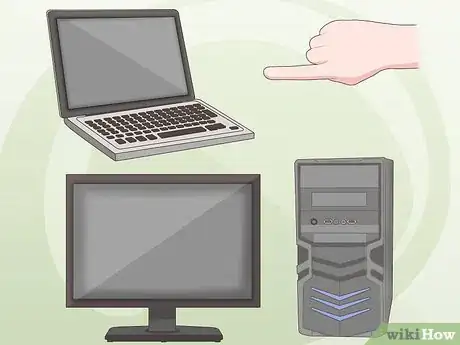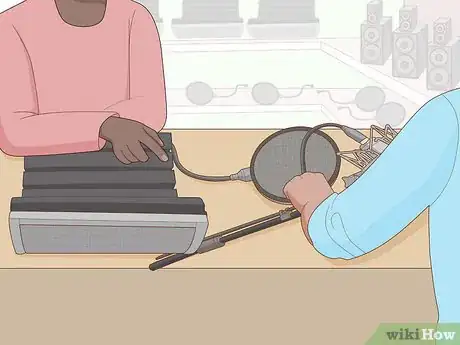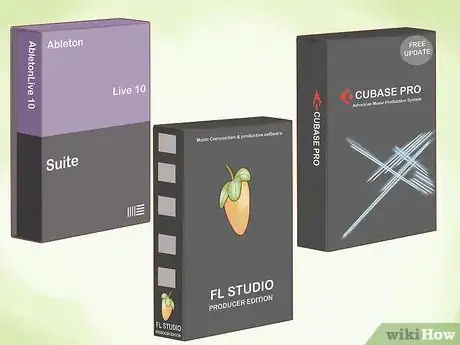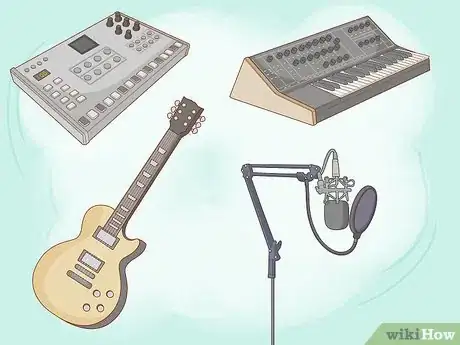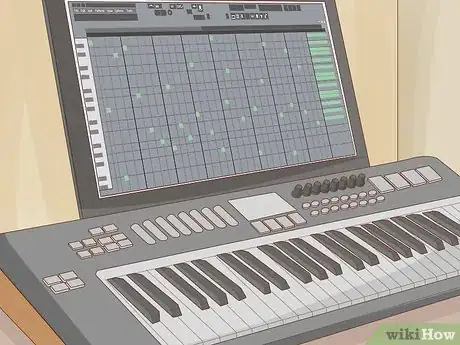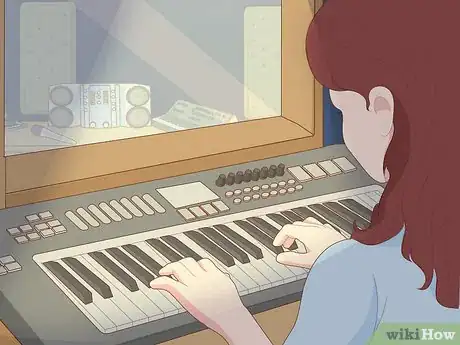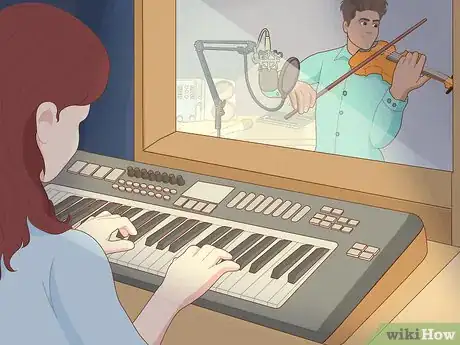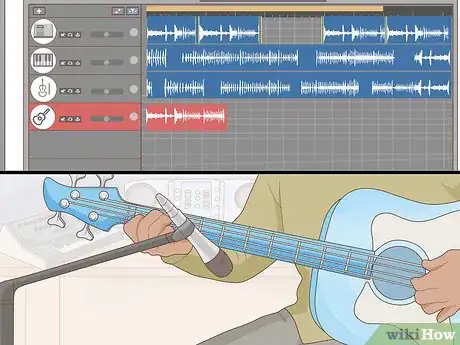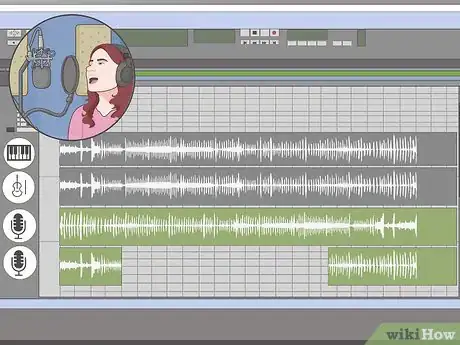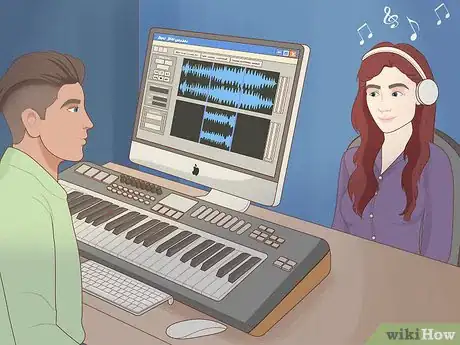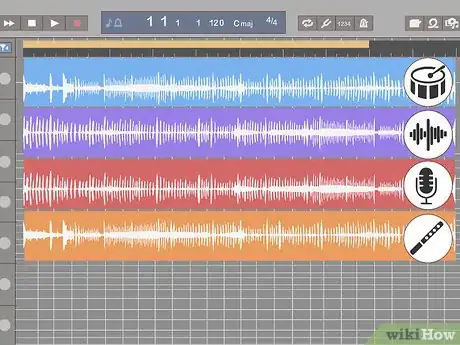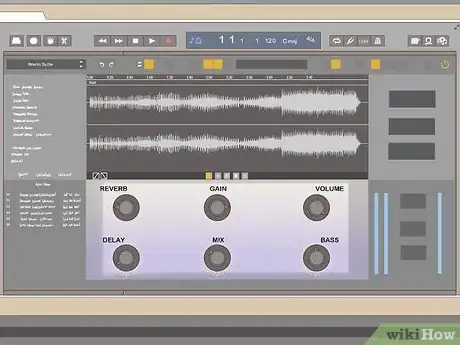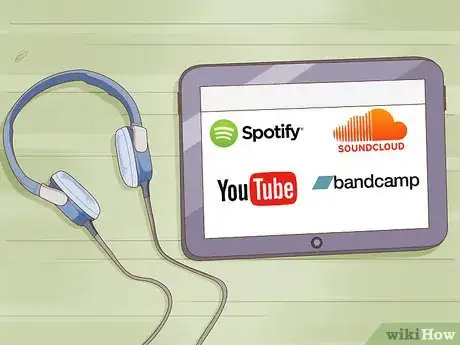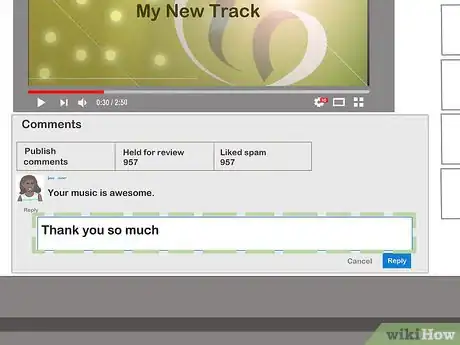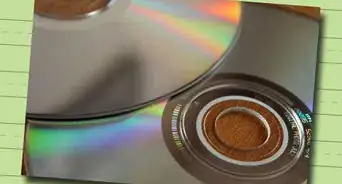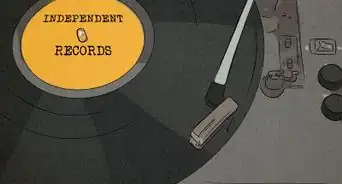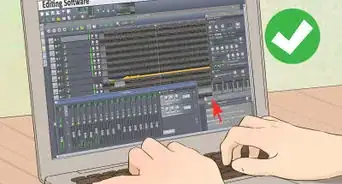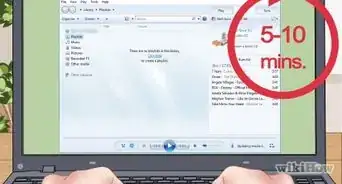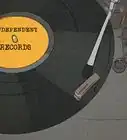This article was co-authored by Timothy Linetsky. Timothy Linetsky is a DJ, producer, and music educator that has been making music for over 15 years. He is a certified Ableton trainer and creates educational YouTube videos focused on producing electronic music. He has over 90,000 YouTube subscribers.
There are 18 references cited in this article, which can be found at the bottom of the page.
This article has been viewed 116,443 times.
Hip-hop and pop music production incorporate all elements of hip hop and pop music creation, though “production” generally refers to the instrumental and non-lyrical. Basically, hip hop and pop music producers are instrumentalists that make these kinds of songs.[1] This work involves using things like samplers, drum machines, synthesizers, digital audio workstations (DAWs), and live instruments. Equip yourself to produce, make the beat, add instrumentals, include vocals if you desire, and finish the track so its quality is top notch.
Steps
Equipping Yourself to Produce
-
1Choose between physical and digital production. Unless you’re a member of a band or you have access to a recording studio and can convince some musician friends to jam out, you’ll be producing most of your sound digitally. You might also record a drummer friend or a sick guitar riff and use these live samples as part of production.
- Generally, live samples will sound most natural. Human listeners crave imperfection in sound production, and live performers each have their own unique, imperfect style.[2]
- Sometimes you can convince musician friends of yours to take part in live sampling if you give them credit or acknowledge them.
EXPERT TIPTimothy Linetsky is a DJ, producer, and music educator that has been making music for over 15 years. He is a certified Ableton trainer and creates educational YouTube videos focused on producing electronic music. He has over 90,000 YouTube subscribers.Music Producer & Instructor
 Timothy Linetsky
Timothy Linetsky
Music Producer & InstructorTry experimenting with a mix of live and digital sounds: Timmy Linetsky, a YouTube DJ, says, "I always love to use a balance of both digital sounds and organic textures. It's always really awesome combining the two. Digital has a lot of power—it feels really big and punchy and in your face, and really abrasive sometimes too. Live samples have textures that are very hard to recreate digitally because the sound is so dynamic."
-
2Build or buy a suitable computer. If you want to independently produce your own tracks, a computer that can run music production software will be necessary. When selecting a suitable computer, consider:
- Investing in a laptop if you plan on traveling or performing live. This will enable you perform live more easily, as your entire selection can be stored and transported on your laptop.
- Investing in a desktop if you plan on producing music on your own at home. These machines will faithfully run most audio production software.
- Using a Mac if you plan on using the digital audio workstations (DAWs) Pro Tools, Garageband, or Logic. These programs are either Mac-only releases or are designed to work best with Mac specifications.
- Prioritizing processor speed. A 3.0 processor that’s a dual core or better will help your computer to run fluidly with little to no lag.
- Using 8 GB of RAM and 500 GB of hard drive space (minimum) to support an extensive sound library and the smooth-running of your computer.
- Saving money on your video card. Unless you also do video editing, a high-end video card won’t add much to your music production.[3]
Advertisement -
3Invest in recording equipment. Recording equipment can add a significant expense to your equipment costs. Most digital audio workstations (DAWs) can digitally produce sounds so entire tracks can be made on the computer. Recording equipment includes things like microphones, booms, filters, sound booths, and so on.
- Recordings of live players generally are warmer and require less finishing. Isolated soundbites can sound cold, which can be corrected in the finishing stage of the production process.
-
4Select a suitable DAW. A digital audio workstation (DAW) will give you the most freedom with production. Many DAWs come with digital drum machines, synthesizers, soundbite libraries, and more. Some popular DAWs you might consider include:
- Image-Line FL Studio is the frontrunner among the Fruity Loops platform. This powerful DAW includes an Image-Line lifetime free update policy.
- Ableton Live is powerful as a recording program for composers and it works well as a performance instrument as well. This program is supported by interface hardware like the Push 2 controller, which allows for a physically reactive (push key sound production) kind of music production.
- Steinberg Cubase Pro offers unique interface options, like chromatic sampling and the Lower Zone project window to improve mixing and other fine-tuning tools panels/tabs.[4]
-
5Purchase suitable production and recording accessories. It can be difficult capturing the explosive nature of a musical instant when only dealing with abstract sound information in computer files. Physical production and recording equipment, like drum machines, microphones, synthesizers, keyboards, electric guitars, and controllers can make production and recording more intuitive and interactive.[5]
- Identify pieces of equipment you’d likely use often in your production. For example, if you had musical training in piano, a quality keyboard would likely be a useful investment.
- This kind of equipment can be very expensive. Building up production and recording accessories generally takes time and continual investment.
- Even though this equipment can be useful, canned music production, like drum machines, oftentimes require extensive finishing before sounding natural.[6]
Making a Beat
-
1Create the bassline. This is the foundation of your track. The bassline will be the lowest tone in the track, generally a drum or keyboard tone. It is often repetitive and steady, though some basslines are characterized by more complex structure, like drum and bass, which uses a syncopated beat.[7]
- Use the steady beat of a kick drum to create a basic bassline.
- Count rhythms and add in offbeats, like a sixteenth note run on the second and fourth beats of your bassline.
- You never know what you’ll come up with when making your bassline. Let your instincts guide you. Don’t attempt for perfection; creating a starting point is the goal of this step.[8]
-
2Incorporate supplemental percussion for variety. Drums and cymbals give a lot of punch to the tracks you produce. A steady kick drum (or bass drum) might work for the main bassline, but a drumroll on a snare drum or the clap of a high-hat will add more depth to your bassline.
- These percussion riffs generally occur at regular intervals or as part of loops throughout a track. The frequency of these will depend on your style and preference.
-
3Loop the through line of the bass and plan for digressions, if desired. The through line of your bass will be the repeated, steady theme of the bass part. This, however, will change at times to showcase solos, to highlight parts, to spotlight instrumental duets or vocals, and so on. These digressions keep your bassline from becoming too repetitive and boring.
- A bridge is a connecting musical interlude to the main through line of a song, usually occurring in the middle of the song. Experiment with changes in rhythm, melody, and more when including bridges in your tracks.[9]
- Be careful not to add too many parts to your bassline. Too much instrumental variety can result in a muddy sound. Two to three instruments here would be most suitable to start with. Use simple, repeatable patterns.[10]
Adding Instrumental Parts
-
1Construct the melody. The melody of your song is the main part of a song that rises and falls, creating the pattern around which the rest of the track is structured.[11] Think of the melody as the main part of a song you’d hum along with.
- Choose a main instrument for your melody. Popular choices include the guitar, keyboard, horns (like trumpets or trombones), organs, synth tones, wind instruments (flutes, clarinets), and more.
- Have your melody travel a range of tones to give it contour. Break up tones to skip up and down to higher and lower tones. Make chords by playing tones together.
- Don’t be afraid to use silence. Adding a slight pause (often referred to in music as a “rest”) to your melody can build tension.
- Your melody should consist of a single instrument. In some cases, a pair of instruments can also be used. When starting out, using more than one instrument might cause muddiness or oversaturation in the end result of your track.[12]
-
2Accent the melody with other instruments. Two instruments here is a good place to start. Too many instruments in your track can weigh down its sound, making it heavy and indistinct.[13] Play these accent instruments in harmony to the melody. Add them sparing throughout the melody to accent the overall contour of the through line.[14]
- Popular instruments used supplemental to the melody include: keyboard (sparse notes), trumpets, trombones, flutes, clarinets, marimbas, accordions, bagpipes, and others.
-
3Emphasize important parts of your track. At a climactic moment, like after you’ve built up some tension in your track and are getting ready to drop the beat, you can add emphasis with instrumental riffs. These are especially popular on the guitar and piano, and can often be used effectively in power chords.
- A few accent notes at low, downtempo spots in your song can add depth and an edgy sense to its overall tone.
- Unusual sounds, like DJ Premier’s iconic use of birds chirping to highlight the potent drumline, can have a profound effect on your track.
- Remember to keep things simple when you’re adding instruments to your melody and bassline. It’s easy to get carried away, but this can negatively impact the instrumental balance in your song.[15]
Including Vocals
-
1Produce the main vocals. Your main vocals are generally sung by a single person. The main vocals in most cases follow along with the melody to the beat of the bassline, though there may be times when a vocalist harmonizes with the instrumental melody or vice versa.[16] Depending on the track you are producing, you may even want to leave out vocals.
- Write lyrics for your song that mean something to you or that are in line with the feeling you want to convey with your song.
- When starting out, one set of main vocals might be best. Secondary vocals, like that of a guest vocalist or a duet, can be effective in your track, but might be hard to balance while learning the basics of production.
-
2Integrate background vocals for harmony. There are moments, like at the end of a verse or the chorus, where the main vocals can oftentimes be naturally accented with harmony. Experiment by adding harmonic vocals to moments of high tension, the ends of musical phrases, and parts of the song you want to stress.
- Adding too many harmonic vocals, much like adding too many instruments, can bog down your sound, making it muddy. Use supporting harmonic vocals sparingly.[17]
- Your placement of these vocals is ultimately a matter of preference and taste. Experiment by harmonizing at various points in the song and seeing what you like.[18]
-
3Overdub the main vocals for emphasis. This is a good way to limit supplemental vocals from muddying your sound. At moments you wish to emphasize, like at the end of a phrase or on some killer lyrics, double or triple the main vocal to create a fuller sound.
Finishing Your Track
-
1Get a second opinion. Have others listen to your song. Be prepared for critique. Listen to the feedback of others carefully. Soften sounds that are piercing and tinny, add substance to the parts your listeners find lacking. This might involve adding more instrumentals or simply balancing the volume.
- Start by having friends and family listen to your track. However, these people will often care about your feelings and may not give you the most honest evaluation.
- After building your confidence a little bit, have someone who isn’t as close to you, like an acquaintance or colleague with similar music tastes, listen to your track.
-
2Mix your track. Keep the volume moderately low when doing this. Over long mixing sessions, volume tends to creep upward, which can be bad for your hearing. Color code parts to improve efficiency while mixing. Balance the volumes of the parts of your track and accentuate prominent parts.
- Compression tools can help you maintain consistent volume throughout your track. Digital versions of these are available as part of DAWs or supplemental software packages.
- EQs (Equalizers) can help give instruments/sound their own space in the mix by boosting or cutting frequencies, thus avoiding clashes that can make elements in the mix difficult to hear.
- A common color scheme to improve mixing efficiency uses purple for bass, blue for drums, red for vocals, and orange for instruments. [20]
-
3Master the track. Take a look at the audio range of the track as a whole in a mastering program. This may be a separate program or part of your DAW. Look at the fades, the parameters of the sound (how large/small its frequency). Soften and round out extreme parts to make the sound fluid and seamless.[21]
Becoming a Successful Producer
-
1Post your songs. The tracks you produce won't gain popularity unless you make them available to the public. Post your songs to platforms like YouTube, SoundCloud, Bandcamp, Spotify, and more. Include relevant tags for your songs so listeners can search for and find your music more easily.[22]
- Include genre specific tags, like one for hip hop or pop, and subgenres where applicable, like Electro Pop.
- Keep an eye on tracks you post. Tracks with many likes, thumbs ups, or positive responses can guide your production of future tracks.
-
2Cultivate a following through social media. Many fans like to know what their favorite artists are saying about daily events. Interact with your fans on Twitter, Facebook, YouTube, and similar social networking sites. Use social media to communicate with local DJs and producers in your city or region. Post information on upcoming tracks.[23]
- Developing a following on social media can be a lot of work. In many cases, producers use a publicist or agent to manage their social media accounts.
- Sponsor social media contests, like one-on-one question and answer sessions or merchandise giveaways.[24]
-
3Network with music professionals. Make a business card and bring it to clubs and live music events. Hand your card to DJs, event coordinators, club managers, and other individuals. Attend after parties for events and shows to solidify your relationships with acquaintances involved in music production.[25]
- If you receive the contact information from someone involved in the music scene, send them a friendly message or an invitation to collaborate.[26]
-
4Perform your tracks or have local DJs perform them. Go onstage as a DJ and showcase your tunes. If you're more of a behind-the-scenes producer, contact local DJs or club music planners through social media or personal connections. Introduce them to your best work, then see if they'll play one of your songs.[27]
Community Q&A
-
QuestionWhere should I promote my songs online?
 Community AnswerPromote via as much social media as possible. You don't have to only advertise on only one platform. Get the word out, and have your friends re-post your stuff. Try Soundcloud, too.
Community AnswerPromote via as much social media as possible. You don't have to only advertise on only one platform. Get the word out, and have your friends re-post your stuff. Try Soundcloud, too. -
QuestionIs it easy to write a song?
 Community AnswerDepends on the song. I write my own things; some I’ve written in about 5 minutes on the toilet or an hour while out taking a walk, others have taken days, weeks or even up to 3 months.
Community AnswerDepends on the song. I write my own things; some I’ve written in about 5 minutes on the toilet or an hour while out taking a walk, others have taken days, weeks or even up to 3 months.
References
- ↑ Ross, Alex. Listen to This. Classical Music Reviews, Fourth Estate, N.p., 2017.
- ↑ https://mic.com/articles/113504/science-shows-why-drum-machines-will-never-replace-live-drummers#.vbepTULsp
- ↑ http://www.wirerealm.com/guides/top-10-best-computers-music-production
- ↑ http://www.musicradar.com/tuition/tech/the-20-best-daw-software-apps-in-the-world-today-238905
- ↑ http://tweakheadz.com/hip-hop-beat-construction-made-easy-the-elements-of-a-beat-arranging-beats-orchestrating-beats-sound-creation-and-production-tips-for-hip-hop/
- ↑ https://mic.com/articles/113504/science-shows-why-drum-machines-will-never-replace-live-drummers#.9O0WSYaKL
- ↑ http://tweakheadz.com/hip-hop-beat-construction-made-easy-the-elements-of-a-beat-arranging-beats-orchestrating-beats-sound-creation-and-production-tips-for-hip-hop/
- ↑ http://www.musicradar.com/tuition/tech/10-hip-hop-production-tips-431654
- ↑ http://www.learneverythingabout.com/lyrics/song-structure-bridges.html
- ↑ http://tweakheadz.com/hip-hop-beat-construction-made-easy-the-elements-of-a-beat-arranging-beats-orchestrating-beats-sound-creation-and-production-tips-for-hip-hop/
- ↑ https://www.britannica.com/art/melody
- ↑ http://edmprod.com/ultimate-melody-guide/
- ↑ http://www.musicradar.com/tuition/tech/10-hip-hop-production-tips-431654
- ↑ http://tweakheadz.com/hip-hop-beat-construction-made-easy-the-elements-of-a-beat-arranging-beats-orchestrating-beats-sound-creation-and-production-tips-for-hip-hop/
- ↑ http://www.musicradar.com/tuition/tech/10-hip-hop-production-tips-431654
- ↑ http://blog.sonicbids.com/5-tricks-to-make-your-vocal-tracks-sound-more-modern
- ↑ http://modernmixing.com/blog/2013/06/07/5-tips-for-mixing-background-vocals/
- ↑ http://tweakheadz.com/hip-hop-beat-construction-made-easy-the-elements-of-a-beat-arranging-beats-orchestrating-beats-sound-creation-and-production-tips-for-hip-hop/
- ↑ http://tweakheadz.com/hip-hop-beat-construction-made-easy-the-elements-of-a-beat-arranging-beats-orchestrating-beats-sound-creation-and-production-tips-for-hip-hop/
- ↑ https://www.landr.com/en/how-to-mix
- ↑ http://www.musictech.net/2016/05/8-ways-to-master-a-track/
- ↑ https://theproaudiofiles.com/music-production-career/
- ↑ https://theproaudiofiles.com/music-production-career/
- ↑ https://www.entrepreneur.com/article/251620
- ↑ http://www.avidblogs.com/5-essential-tips-for-becoming-a-successful-music-producer/
- ↑ https://theproaudiofiles.com/music-production-career/
- ↑ http://edmprod.com/ultimate-cheat-sheet-becoming-great-producer/

